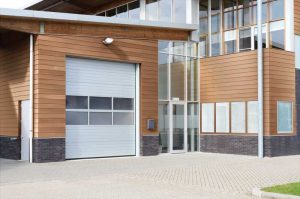
Engineered cladding products
Appearance
While engineered cladding products, such as fiber cement, may be embossed with a woodgrain pattern, they must be painted, which means there will be no multi-chromatic streaking that gives composite cladding the authentic and natural appearance of wood. Engineered cladding products are also prone to fading and cracking.
Installation
Since engineered cladding releases silica when cut, the Occupational Safety and Health Administration (OSHA) requires exposure controls and protective equipment for all installers. A specialized blade is also needed to reduce silica dust. The material can break under its own weight, so it requires careful handling to avoid product loss. Installation can vary based on climate and wind requirements, which makes scheduling more difficult.
Durability
Engineered cladding products tend to be brittle and can fracture if nailed close to the edge. The finish and face can spall (flake or break off) in cold environments. Like wood, the amount of water that engineered cladding absorbs depends on the quality and age of the finish, so it must be effectively maintained to prevent deterioration. Engineered cladding is highly susceptible to impact damage and freeze/thaw cycles.
Recycled content
Engineered cladding contains no recycled content.
Stucco
Appearance
Unlike plank cladding, stucco has a very limited range of appearances, and there are limited trim options that work well with the material. Stucco is resistant to rot, mold, fire, and insects. Moreover, it is often used in drier climates since it is prone to moisture-related issues.
Installation
Stucco is very labor-intensive to install, requiring a two- to three-step application plus painting (dash coat, scratch coat, brown coat, and finish coat) by a concrete contractor. Since it is made of cement sand and water, stucco is heavy. All layers of stucco must be uniform to perform well. Additionally, stucco requires two layers of building paper or wrap plus lath reinforcing. Improper installation can result in extensive interior wall and structural damage.
Durability
Stucco is prone to cracking due to its brittle nature, particularly if the foundation of the building settles. Stucco is also porous and will absorb water more readily than other materials, which can cause it to develop dark spots or grow mold. The material is sometimes affected by freeze/thaw cycles.
Recycled content
Stucco typically does not contain recycled content, although some may use post-consumer recycled sand aggregate from crushed, screened waste concrete.
Brick and stone masonry
Appearance
Both brick and stone have a classic look often seen on more traditional homes. These materials have a wide range of aesthetics beyond typical red brick and field stone. Brick is available in different colors and course patterns, and can be painted, while stone can be laid in a variety of patterns. Manufactured brick and stone veneers offer another option.





Fantastic insights into the future of sustainable construction! This article beautifully highlights the benefits of composite cladding in achieving zero waste and enhancing design sustainability. Well-written and inspiring.